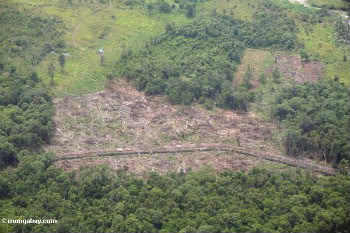|
|
Restoration efforts can return polluted or degraded landscapes to previous states in less than a lifetime, according to study Yale School of Forestry and Environmental Studies. The study rebuts a common assumption that ecosystem recovery takea centuries, even millennia.
Yale researchers analyzed 240 independent studies that explored the recovery of degraded ecosystems due both to human-caused disturbances and natural disasters. In the meta-analysi,s published in PLoS ONE the researchers, found that on average forests recover in 42 years, while ocean bottoms recover in less than a decade. Ecosystems that suffered from a variety of disturbances took on average 56 years, while those recovering from mining, invasive species, oil spill, and trawling recovered on average in only 5 years.
 Deforestation in Borneo. A new meta-analysis estimates that it takes on average 56 years for forests to recover. Photo by: Rhett A. Butler. |
“The damages to these ecosystems are pretty serious,” said Oswald Schmitz, co-author of the study. “But the message is that if societies choose to become sustainable, ecosystems will recover. It isn’t hopeless.”
The study found that ecosystems largely recovered quicker from natural disasters than from human ones. In addition, aquatic ecosystems recovered quicker than terrestrial ones.
“Restoration could become a more important tool in the management portfolio of conservation organizations that are entrusted to protect habitats on landscapes,” added Schmitz.
The meta-analysis reported that 67 of the 240 ecosystems studied showed no recovery, however over half of these ecosystems were probably studied before recovery could occur. The study estimated that 15 percent of the ecosystems studied were beyond recovery.
The researchers pointed out that the study focused on an ecosystems’ recovery to its state before the identified disturbance. However, they note that these recoveries may not mean the ecosystem returned to a truly natural state. In fact they believe that many of the ecosystems had likely already experienced large-scale changes due to human activities, such as loss in biodiversity, loss in water and air quality, and climatic changes.
“We recognize that humankind has and will continue to actively domesticate nature to meet its own needs. The message of our paper is that recovery is possible and can be rapid for many ecosystems, giving much hope for a transition to sustainable management of global ecosystems,” concluded co-author Holly Jones, and Yale Ph.D. student.
Related articles
Could engineering rainforests save the planet from global warming?
(01/21/2009) At the Smithsonian symposium entitled “Will the Rainforests Survive?”, leading tropical biologists vigorously debated current threats to the rainforest and what the future may hold. While climate change was identified as a leading threat to rainforests, many of the scientists argued that the tropics may also be the key to mitigating the impact of global warming.
Indonesian coral reef recovering after devastating tsunami and years of destructive fishing
(01/05/2009) On December 26th, 2004 an earthquake recorded at a magnitude of 9.3 in the Indian Ocean created a massive tsunami that struck nations across the region. Enormous waves took the lives of nearly 250,000 people while destroying cities and towns in minutes. The tsunami also caused extensive environmental damage, including reef systems along many coastal areas.
Recovery from worst mass extinction took 30 million years
(01/20/2008) The recovery of complex ecosystems following history’s worst mass extinction took 30 million years reports a study published last week in Proceedings of the Royal Society B.